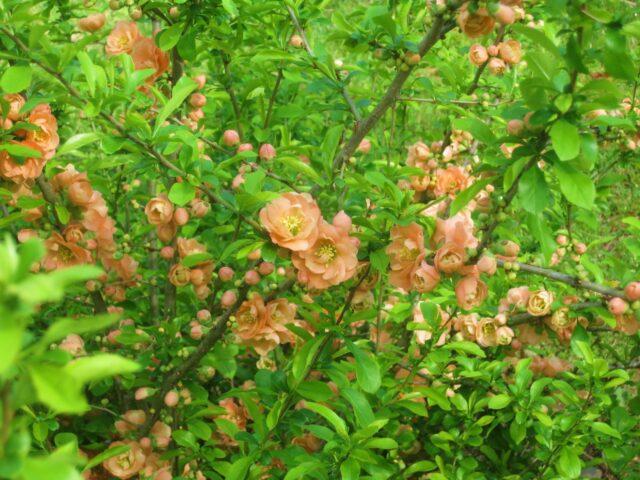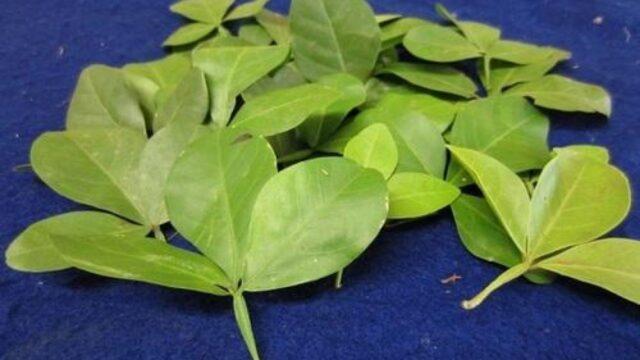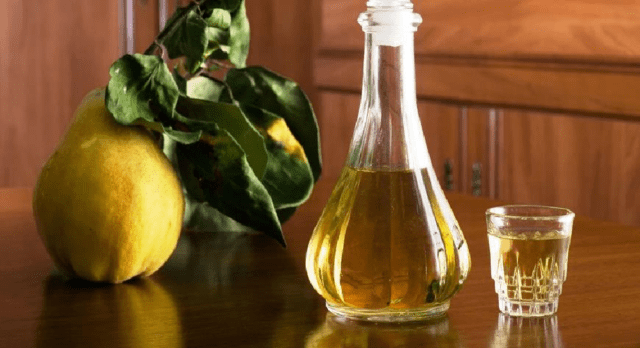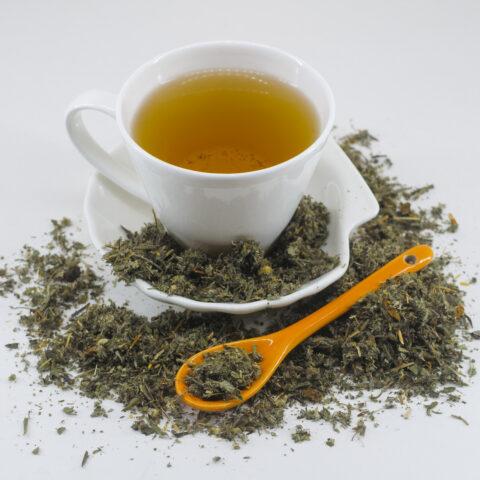Content
The healing properties of quince leaves and contraindications are associated with the chemical composition of the plant. It contains vitamins, minerals and other beneficial compounds. Therefore, the leaves are used to normalize blood pressure, cleanse blood vessels, as an additional agent in the treatment of asthma and bronchitis. The broth is also used for cosmetic purposes - in the form of a foot bath and a hair rinse.
What does a quince leaf look like
Quince is a tree that can be found in Russia in the Krasnodar Territory, in the regions of the North Caucasus and in the Crimea. It is appreciated for the fruits that are used in cooking.

Quince leaves have healing properties
Externally, the sheet plates have a rather interesting shape. They are oval, sometimes ovoid, not too narrow. They reach 11–12 cm in length and 6–7.5 cm in width. The tops of the leaves can be both pointed and obtuse. The color is saturated dark green, which indicates readiness for collection and harvesting. The underside is slightly grayish.
Chemical composition
The benefits of quince leaves are determined by their rich chemical composition, which includes the following substances:
- B vitamins (B1, B2, B6);
- provitamin A;
- vitamin C;
- vitamin P;
- carbohydrates (fructose, glucose);
- pectin substances;
- organic acids (tartronic, citric, malic);
- tanning components;
- mineral compounds (potassium, phosphorus, calcium, copper).
The special value of quince leaves is that it contains such a rare compound as the glycoside amygdalin (vitamin B17). It is a biologically active substance that strengthens blood vessels and the heart, and also helps to normalize metabolism. Therefore, it is believed that in terms of vitamin and mineral composition, quince leaves are even healthier than apple fruits.
Another valuable substance is tartronic acid. It promotes weight loss as it prevents the accumulation of fat. This is due to the fact that the substance prevents the conversion of carbohydrates from food into fat molecules. Therefore, quince leaves can be regularly used to make tea for those people who seek to lose weight and maintain a healthy shape.
Why are quince leaves useful for the human body
Due to its rich chemical composition, quince leaves have a beneficial effect on the body:
- anti-inflammatory;
- astringent;
- expectorant;
- antimicrobial;
- enveloping;
- hemostatic;
- diuretic;
- immunostimulating.

Tea made from quince raw materials strengthens the immune system, cleanses blood vessels and helps to normalize blood pressure
Why is tea made from quince leaves useful?
The drink is used as one of the means for the prevention and treatment of diseases:
- diabetes;
- high blood pressure;
- liver disorders;
- pathology of the kidneys, ureter;
- asthma, bronchitis, cough;
- ARVI;
- digestive disorders;
- poisoning;
- malaise, weakness;
- anemia;
- inflammatory processes in the pancreas;
- weight correction.
If the patient has a chronic illness, the main course of treatment should be followed. The use of quince leaves must be agreed with your doctor.
Methods of preparation and use
The foliage can be collected on your own or you can buy ready-made dry raw materials at the pharmacy. It is quite convenient - the drug is available, and it can be stored for 1–1.5 years without losing its medicinal properties. On the basis of crushed raw materials, an infusion, tea and alcoholic tincture are prepared.
Tincture

It is better to prepare alcoholic tincture with medical alcohol, but if it is not available, you can take vodka.
The proportions are as follows:
- crushed raw materials - half a glass;
- vodka - 200 ml.
Cooking instructions:
- You need to take the raw material, put it in a small container.
- Fill with alcohol.
- Close the lid and put away in a dark place.
- Insist for 10 days, stirring occasionally.
- Strain and take as a medicine.
This tincture can be stored for a long time in the refrigerator - alcohol preserves all medicinal components well.
Infusion
Along with alcohol infusion, you can also prepare water. In this case, you need to act like this:
- Take 100 g of chopped leaves.
- Pour 1 liter of warm water (you can 80 degrees).
- Close with a ceramic lid and let stand for an hour.
- When the infusion has cooled, it is filtered.
You can also store it in the refrigerator, but only for 7-10 days.

The water infusion is prepared in small quantities, which can be used several times.
Tea
The benefits and harms of tea made from quince leaves are related to its chemical composition. It is a vitamin drink that can be prepared every day and used in place of regular tea or coffee.

To prepare a tea drink, it is enough to take one spoonful of dried quince leaves
Algorithm of actions:
- Take 1 tbsp. l. chopped foliage.
- Put boiling water in a glass.
- Close with a ceramic lid.
- Let it brew for 40 minutes.
- Strain and divide into 3-4 portions (can be diluted with boiling water).
- Drink preferably during the day.
Decoction in a water bath
To obtain a more saturated extract of nutrients, it is recommended to prepare an aqueous decoction:
- Take one tablespoon of raw materials.
- Pour a glass of boiling water over.
- Put in a water bath and stand for 15 minutes over low heat.
- Then close the lid and let stand for another hour until it cools completely.
- Strain.

The broth should be consumed in 1-2 days.
Vitamin salad
Well-chopped fresh leaves can be mixed with honey, lemon, and walnuts. It is enough to eat one tablespoon of this salad every day to replenish the need for B vitamins, as well as valuable polyunsaturated fatty acids.
Application in traditional medicine
In folk medicine, all the recipes described are used - tea, broth, infusion. In most cases, they are used internally, although external use is also allowed for healing wounds and strengthening hair. The standard course of treatment lasts one month, after which you can take a break for a week and repeat the cycle. As a rule, there are no side effects. But if the state of health has worsened, treatment should be stopped and a doctor should be consulted.
Quince leaves for diarrhea
Diarrhea can be treated with a simple recipe. Take a tablespoon of raw materials and pour boiling water, and then warm up in a water bath for 15 minutes, insist for another hour. The remedy is taken three times a day, two tablespoons of broth (always after meals).

Quince leaves help to quickly cope with diarrhea
Quince leaves from pressure
Alcohol tincture is used to normalize high blood pressure. To do this, you need to mix 20 drops of herbal composition and 50 ml of water (a quarter of a glass). This mixture is taken twice a day 20-30 minutes before lunch.
For the treatment of bronchitis and asthma
For the treatment of bronchitis and asthma, a decoction of the leaves in a water bath is used.Take it four times a day between meals (2 tbsp. L.). The effect is noticeable already in the first 1-2 weeks. Patients note that the attacks of painful coughing become significantly less.
To strengthen hair
To strengthen the hair, an aqueous infusion is used, which must be prepared for at least an hour (until it cools completely). They rinse their hair after a shower. Use three times a week. Thanks to this, the hair follicles are strengthened, dandruff disappears. In the reviews, people note that the infusion is able to paint over gray hair.
Foot bath
Another option for external use is a foot bath. For its preparation, several components are taken in equal amounts:
- quince leaves - 2 tbsp. l .;
- nettle - 2 tbsp. l .;
- sage - 2 tbsp l.
They are brewed with boiling water (1 l) and infused for an hour. Then filter and add 3 tbsp. l. sea salt, add a liter of warm water and make a foot bath for 20-30 minutes. The procedure is repeated every day (preferably before bedtime).
Contraindications
Along with the beneficial properties of quince leaves, there are contraindications to their use:
- pleurisy;
- chronic constipation (especially in the elderly);
- inflammation of the vocal cords;
- use with antibiotics;
- pregnancy and lactation (as agreed with the doctor);
- children under 3 years old.
Before using a folk remedy, you need to test it in small doses. If no allergic reaction occurs, the composition can be applied.
Collection and procurement
Quince leaves are harvested during the entire warm period. It is advisable to do this in summer and early autumn. It is better to collect in dry weather, when there is not even short-term rains. The leaves are picked by hand, laid out in one layer on a flat surface and dried in a ventilated room or outdoors. In this case, access to direct sunlight should be avoided.

You need to collect quince leaves in dry and warm weather.
Another way is to spread it on a baking sheet and dry in the oven at a temperature of no more than 50 degrees. Then the foliage is crushed and stored in paper, cloth bags or in a well-closed jar. Standard conditions - room temperature, low humidity (up to 70%), dark place. Raw materials can be kept without loss of medicinal properties for a year.
Conclusion
The medicinal properties of quince leaves and contraindications have been studied quite well. Means based on dry raw materials (in the form of an aqueous decoction or alcohol tincture) practically do not give side effects. Therefore, they can be used both internally and externally.








